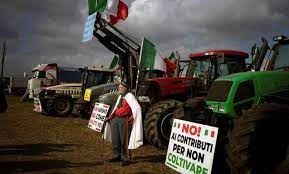Andrew Hammond
The European Green Deal has been one of the signature features of European Commission President Ursula von der Leyen’s term of office. However, there are increasingly clear signs that this flagship policy may transition to a new phase this year, with a stronger emphasis on decarbonization and less focus on biodiversity and nature conservation.
A key driver for this potential evolution is a growing “greenlash” (backlash against green policies) across much of Europe. Recent days, for instance, have seen significant farmer protests in countries such as France, Italy, Spain, Romania, Poland, Greece, Germany, Portugal and the Netherlands.
Some of this discontent relates to local agricultural grievances in individual nations, but there is also a broad-based anger over cross-cutting economic, regulatory and green policies. Farmers across the continent highlight how costs of energy, fertilizer and transport have grown, while governments have been trying to keep a lid on rising food prices caused by the inflation spike following the COVID-19 pandemic.
Farmers’ discontent is widely seen as part of a broader political backlash, driven by conservatives, against key elements of the European Green Deal. Even the moderate right-of-center European People’s Party has recently partnered with the far-right European Conservatives and Reformists to oppose elements of the European Commission’s green legislation. This includes the Nature Restoration Law, which will see the EU restoring at least 20 percent of the bloc’s degraded areas by the end of the decade and all sites in need of restoration by 2050.
This political backlash may grow significantly in the context of the coming European Parliament elections. As opinion polls from this month show, the most likely election headline in June is a surge in support for right-wing and euroskeptic parties that are dubious of the European Green Deal.
This was highlighted by the strong support for the Freedom Party in last November’s Dutch election. Indeed, the rightist European Conservatives and Reformists may become the third-biggest group in parliament. This coalition includes Italian Prime Minister Giorgia Meloni’s far-right Brothers of Italy party. The far-right Identity and Democracy group, which includes Alternative for Germany, may also make sizable gains.
The biggest election losers might be the European Greens. One of the consequences might therefore be an anti-environmental majority in the parliament for the first time. This further indicates that the next stage of the European Green Deal could see a strong emphasis on decarbonization targets, with less political emphasis on sustainability issues around biodiversity and nature conservation.
Only this week, there have been new signals of this potential bifurcation in the European Green Deal, which has seen more than 50 major sustainability initiatives announced by the Von der Leyen-led European Commission since 2019. Successful as some of this agenda has been, the so-called greenlash may well mean that a different approach is coming on sustainability issues around biodiversity and nature conservation, especially if they continue to grow in controversy. The latest signal of this came on Monday, when Von der Leyen announced the withdrawal of a contentious pesticide law known as the Sustainable Use Regulation.
This had the ambitious goal of slashing the use of pesticides in half by 2030 and also envisioned the total prohibition of these products in sensitive areas, promoting the uptake of low-risk alternatives. Laudable as this might be to many, however, Von der Leyen said this week that the “proposal has become a symbol of polarization.” This reversal is far from a one-off. Last week, the European Commission said that it would recommend a one-year delay to the introduction of rules that require farmers to keep a certain amount of land fallow or nonproductive.
And there was further evidence this week that the European Commission is doubling down on its decarbonization agenda, for which there is strong corporate interest. Part of the reason for this private sector attraction is the huge array of investment opportunities. The European Commission, for instance, estimates that reaching net-zero emissions by 2050 will require some €700 billion ($754 billion) in additional investment by the bloc each year. That is a staggering sum.
As Europe seeks to become the first continent in the world to be climate neutral, its positioning at the forefront of this agenda is helping create the pathway for policy innovation, especially around the growing urgency of the energy transition. This is creating new incentives to transform the continent into a more resource-efficient and competitive economy. On Tuesday, just one day after the Sustainable Use Regulation reversal, Brussels announced 2040 climate target proposals for a massive 90 percent cut in greenhouse gas emissions compared to 1990 levels. This will require a huge deployment of renewable systems, the cessation of the use of coal and almost an end to the use of gas in the bloc’s energy system. The recommended 2040 target also entails an earlier deployment of carbon capture, which will generate industrial carbon removals, complementing land-based removals sequestering carbon in biomass and soils and natural carbon removals.
At this stage, these 2040 plans are recommendations for the 27 member states rather than legally binding obligations, with a goal of stimulating multiyear dialogue to reach the targets. However, the direction of travel seems clear. The EU may therefore be at a key tipping point with its European Green Deal. Much could now depend upon the outcome of the European Parliament elections, which may see the election of an anti-environmental majority, fueling the greenlash.







